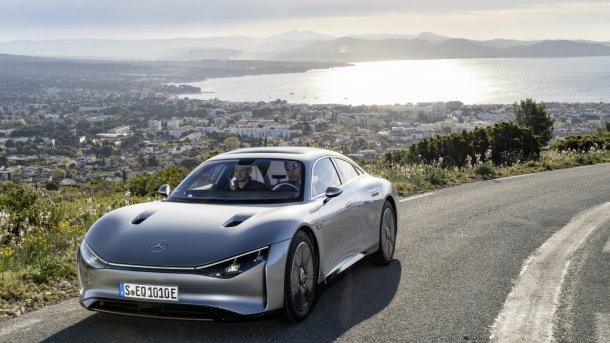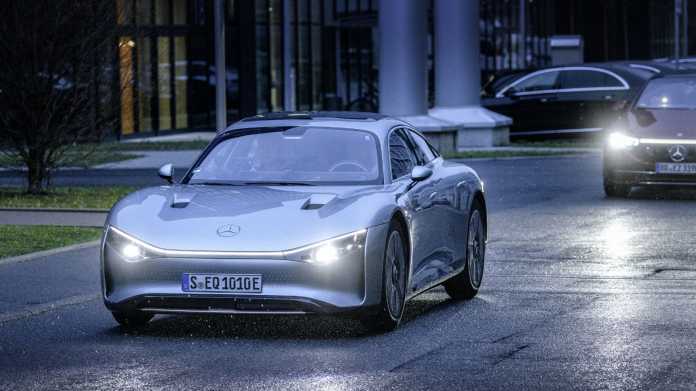The Mercedes-Benz EQXX electric car: Efficiency wins out
Mercedes used only 87 kWh in the EQXX prototype over 1000 km from Sindelfingen to the Côte d'Azur. The implications for series production are interesting.

The ingredients for an economical car have all been known for a long time, they are just not popular at the moment.
(Bild: Mercedes)
- Clemens Gleich
(Hier finden sie die deutsche Version des Beitrags)
"Stopping or recharging was not an option," says Markus Schäfer, Mercedes' Chief Technology Officer, after the Mercedes EQXX's 1000 km drive to the Mediterranean Sea without recharging. That's why the TÜV sealed the charging flap. "There are many range rides," says Schäfer. "Most take place at 30 km/h on a circuit. But we wanted to show a drive under real conditions." So a crossing of the Alps naturally lends itself to that. Above all, it's a 449 m descent from Sindelfingen to the Mediterranean, which is always good for measuring fuel consumption. But otherwise there was no dawdling: The car went up to 140 km/h and the average speed was 87.4 km/h. The net consumption average according to the speedometer at the end: 8.7 kWh/100 km. This means: even including charging losses under 10 kWh/100 km, through rain, over Alpine passes, long motorway stages. How does that work?
The biggest secret
Mercedes communicates the excellent drag coefficient of 0.17, which is achieved by the teardrop shape with elongated rear end, which is extended even further from 60 km/h by servo. In addition, there are clever efficiency systems, which we will talk about in a moment. But the biggest savings are in things that Mercedes customers probably won't want to buy in the end. Look at pictures of the car from the front, in the context of the other cars. This is simply a narrow car (by today's standards), it has a small frontal area of 2.12 m². The EQS, on the other hand, pushes 2.51 m² against the wind. Consider further the well-hidden tyre dimension: 185/65 R20 - significantly narrower than is common in most modern production cars. Bridgestone thus achieved a rolling resistance of only 4.7 per mille for the EQXX tyres. The engineers also built the rear axle 5 cm narrower than the front axle so that the problematic turbulence is in the slipstream of the front. Such a slim hip, however, does not look like what is readily called "powerful" in designer-speak.
Over 1.7 tons heavy
Mercedes-Benz EQXX (8 Bilder)

When it comes to weight, Mercedes talks a lot about "consistent lightweight construction", comparing the EQXX in the press release to a "wiry" cyclist who makes up time uphill. After all, a lot of effort has gone into it, right up to brake discs made of aluminium. However, the car weighs 1755 kg. According to the manufacturer, the 100 kWh battery weighs 495 kg. That leaves 1260 kg for the chassis, electric drive and four seats. By comparison, Volkswagen's small-series XL1 has a battery, electric motor, diesel engine, diesel tank, two seats and a body with scissor doors in 870 kg. Not a prototype, but a small series, and probably the best VW ever. Aptera's "Solar Electric Vehicle" accommodates a 60 kWh battery in 800 kg of vehicle instead of VW's diesel engine, with the option of 100 kWh. Despite the smaller vehicles with two seats, Mercedes can take a leaf out of their book for at least half a tonne before "consistent lightweight construction" comes close to an arguable reality.
Economy recipe vs. current trend
Making a vehicle narrower, smaller, lighter and with thin tyres is the long-known basic recipe for economy. This recipe is countered by current dynamics: Manufacturers want to sell bigger, heavier, wider vehicles because they bring more margin. Customers are courted accordingly and buy cars precisely for reasons of social prestige. This creates a spiral that is difficult to break. A large car, however, will consume a lot of energy even with a good cW value, see BMW iX with its good 0.25, which in our test, thanks to a frontal area of 2.82 m², was nevertheless only good for motorway consumption beyond 30 kWh. Nevertheless, there are of course approaches from the EQXX that also take larger cars a bit further.
Fat Boys Running
Let's move on to the things that could become relevant for series production. Markus Schäfer would like to get into the "low double-digit range" in terms of consumption in series production in the medium term, i.e. close to 10 kWh/100 km instead of around 20 as is usual today. In order to reduce the battery weight, Mercedes mounted the cells in the EQXX directly in the battery pack ("cell to pack") instead of in modules. The module frames are missing, battery weight and volume are reduced.
The downside: a non-modular battery can hardly be repaired. Cell-to-pack is therefore a technology that only makes sense together with its own recycling capacities. Tesla, for example, has announced its intention to develop such a system in order to avoid the high lithium raw material prices that are predicted to persist for decades. Something like this could also work for Mercedes models below the middle class. Above that, it might be smart to stick with modules, because their easy repairability allows for correspondingly long battery guarantees and a prestigious long lifetime for the cars.